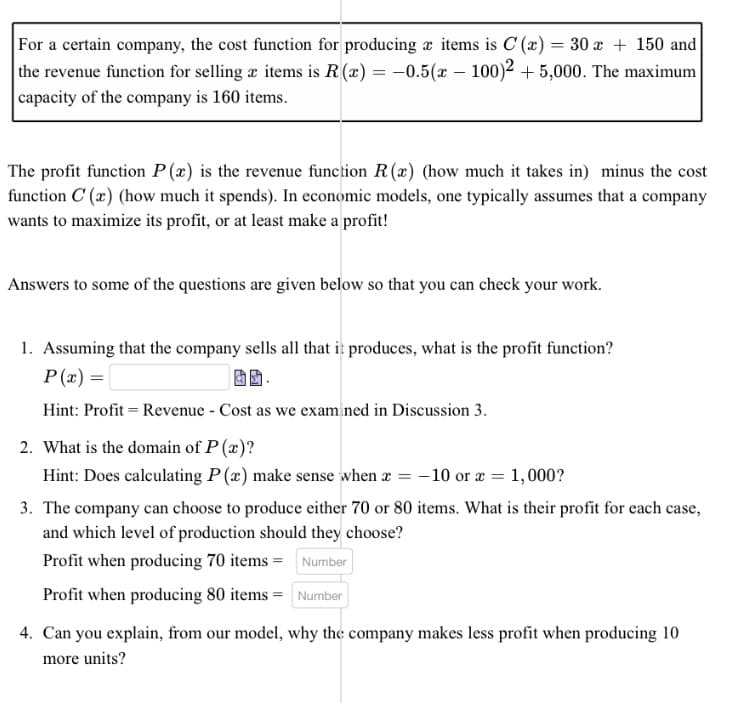For a certain company, the cost function for producing items is C (x) = 30 x + 150 and the revenue function for selling æ items is R(x) = -0.5(x - 100)2 +5,000. The maximum capacity of the company is 160 items. The profit function P(x) is the revenue function R(x) (how much it takes in) minus the cost function C (x) (how much it spends). In economic models, one typically assumes that a company wants to maximize its profit, or at least make a profit! Answers to some of the questions are given below so that you can check your work. 1. Assuming that the company sells all that it produces, what is the profit function? P(x) = Hint: Profit = Revenue - Cost as we exam ned in Discussion 3. 2. What is the domain of P(x)? Hint: Does calculating P(x) make sense when x = -10 or = 1,000? 3. The company can choose to produce either 70 or 80 items. What is their profit for each case, and which level of production should they choose? Profit when producing 70 items = Number Profit when producing 80 items = Number 4. Can you explain, from our model, why the company makes less profit when producing 10 more units?
For a certain company, the cost function for producing items is C (x) = 30 x + 150 and the revenue function for selling æ items is R(x) = -0.5(x - 100)2 +5,000. The maximum capacity of the company is 160 items. The profit function P(x) is the revenue function R(x) (how much it takes in) minus the cost function C (x) (how much it spends). In economic models, one typically assumes that a company wants to maximize its profit, or at least make a profit! Answers to some of the questions are given below so that you can check your work. 1. Assuming that the company sells all that it produces, what is the profit function? P(x) = Hint: Profit = Revenue - Cost as we exam ned in Discussion 3. 2. What is the domain of P(x)? Hint: Does calculating P(x) make sense when x = -10 or = 1,000? 3. The company can choose to produce either 70 or 80 items. What is their profit for each case, and which level of production should they choose? Profit when producing 70 items = Number Profit when producing 80 items = Number 4. Can you explain, from our model, why the company makes less profit when producing 10 more units?
Managerial Economics: Applications, Strategies and Tactics (MindTap Course List)
14th Edition
ISBN:9781305506381
Author:James R. McGuigan, R. Charles Moyer, Frederick H.deB. Harris
Publisher:James R. McGuigan, R. Charles Moyer, Frederick H.deB. Harris
ChapterB: Differential Calculus Techniques In Management
Section: Chapter Questions
Problem 2E
Related questions
Question

Transcribed Image Text:For a certain company, the cost function for producing items is C (x) = 30 x + 150 and
the revenue function for selling æ items is R(x) = -0.5(x - 100)2 +5,000. The maximum
capacity of the company is 160 items.
The profit function P(x) is the revenue function R(x) (how much it takes in) minus the cost
function C (x) (how much it spends). In economic models, one typically assumes that a company
wants to maximize its profit, or at least make a profit!
Answers to some of the questions are given below so that you can check your work.
1. Assuming that the company sells all that it produces, what is the profit function?
P(x) =
Hint: Profit = Revenue - Cost as we examined in Discussion 3.
2. What is the domain of P(x)?
Hint: Does calculating P(x) make sense when x = -10 or x =
=
1,000?
3. The company can choose to produce either 70 or 80 items. What is their profit for each case,
and which level of production should they choose?
Profit when producing 70 items =
Number
Profit when producing 80 items = Number
4. Can you explain, from our model, why the company makes less profit when producing 10
more units?
Expert Solution
This question has been solved!
Explore an expertly crafted, step-by-step solution for a thorough understanding of key concepts.
This is a popular solution!
Trending now
This is a popular solution!
Step by step
Solved in 3 steps with 3 images

Knowledge Booster
Learn more about
Need a deep-dive on the concept behind this application? Look no further. Learn more about this topic, economics and related others by exploring similar questions and additional content below.Recommended textbooks for you

Managerial Economics: Applications, Strategies an…
Economics
ISBN:
9781305506381
Author:
James R. McGuigan, R. Charles Moyer, Frederick H.deB. Harris
Publisher:
Cengage Learning


Managerial Economics: Applications, Strategies an…
Economics
ISBN:
9781305506381
Author:
James R. McGuigan, R. Charles Moyer, Frederick H.deB. Harris
Publisher:
Cengage Learning
